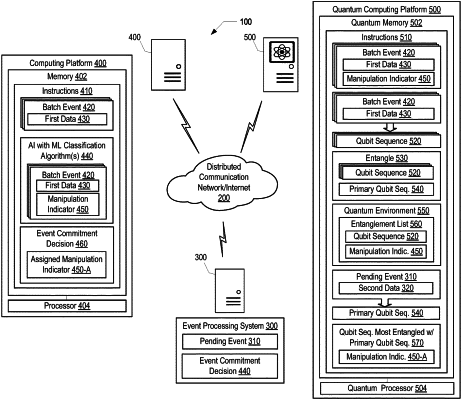| CPC G06N 10/00 (2019.01) [G06N 5/04 (2013.01); G06N 20/00 (2019.01); G06Q 40/04 (2013.01)] | 12 Claims |

|
1. A system for real-time prevention of event manipulation, comprising:
a classical computing platform comprising a first memory, at least one first processor in communication with the first memory, and first instructions stored in the first memory, wherein the first instructions are executable by the at least one first processor and configured to:
receive (i) first data associated with a plurality of historical events having occurred over a predetermined period of time and (ii) one or more denylists that list parties to previous manipulative events, and
using Artificial Intelligence (AI) including at least one Machine Learning (ML) classification algorithm to determine, based at least in part on the first data and the one or more denylists, a manipulation indicator for each of the plurality of historical events, wherein the manipulation indicator provides an indication of a likelihood that the respective historical event was manipulative or is associated with manipulative events; and
a quantum computing platform in communication with the classical computer platform and comprising a quantum memory, at least one quantum processor in communication with the quantum memory and second instructions stored in the quantum memory, wherein the second instructions are executable by the at least one quantum processor and configured to:
receive the first data and the manipulator indicator for each of the historical events,
based on at least a portion of the first data, transform each of the plurality of historical events into a qubit sequence having a predetermined number of qubits,
entangle the qubits in the qubit sequence with qubits in a primary qubit sequence,
generate, in a quantum computing environment, an entangled list of the qubit sequences that includes, for each of the historical events, an association between the qubit sequences and a corresponding one of the manipulation indicators, and
in response to receiving second data associated with a pending event requiring event commitment decisioning, perform, in real-time:
based on at least a portion of the second data, transforming the pending event into the primary qubit sequence,
in response to transforming the pending event into the primary qubit sequence, performing, iteratively, determinations of which historical event has a qubit sequence that is most entangled with the primary qubit sequence, wherein the determinations occur iteratively until a predetermined level of confidence is achieved that the qubit sequence is one that is most entangled with the primary qubit sequence, and
assigning, to the pending event, as indicated in the entanglement list, the manipulation indicator associated with the historical event having the qubit sequence that is most entangled with the primary qubit sequence,
wherein the first instructions of the classical computing platform are further configured to determine, in real-time to receiving notification of the pending event, an event commitment decision based on the assigned manipulation indicator.
|